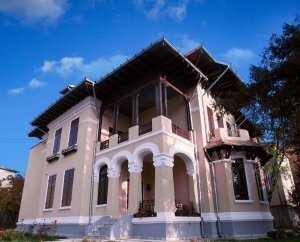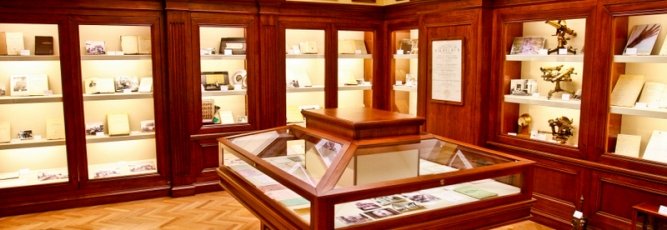Contact
E-mail: muzeul@uaic.ro
Phone: +40 232 20 1102
Address: 12 Titu Maiorescu street, Iaşi
Website: http://www.muzeul.uaic.ro
Manager: Associate Professor PhD Neculai BOLOHAN
E-mail: neculaibolohan@yahoo.com
Prologue
The Museum of „Alexandru Ioan Cuza” University is the result of two complementary traditions and continues the work of several academic structures designed to build the institutional memory.
Scientific mission
The current Museum of „Alexandru Ioan Cuza” University of Iasi aims to exploit its dual heritage, given by the academic vocation and archaeological research. Besides its patrimonial mission, the institution aims to serve as a formative space and to promote academic exchanges, thanks to the setting, within it, of a platform dedicated to the research of the past of higher education institutions and academic culture, generally speaking. The results of these knowledge efforts will be presented in scientific meetings, and the most valuable contributions published in the Museum journal.
Academic collection
The interest in preserving evidence of the university activity lies back in early years, when Titu Maiorescu was the rector of the first modern university in the country. The concerns for saving the institution’s historical heritage increased under the impact of dramatic changes that the Romanian society faced during the 20th century. They determined the destruction of important evidence, particularly buildings and furniture, teaching material and university courses. Other sources remained in several personal archives, while a series of exhibits and documents were fragmented and given in the custody of some institutions, such as Petru Poni Museum, The Museum of the Union, State Archives etc. Thanks to Octav Davideanu, the University Museum functioned within the Rector’s Office and was a real help in saving many objects valuable for the academic life, though not all of them became available for the public. The current location of the institution offers the academic collection a generous space, organized both by thematic criteria and in relation to various historical stages of the higher education in Iasi. Thus, a Rector’s Office is presented, with proper furniture, first academic medals, various seals and some of the university symbols, namely the silver hammer and trowel used on May, 23rd 1893 at the solemnity of settling the fundamental stone of university palace in Copou. A substantial area is allotted to the historical evolution of the institution, as its official opening and the anniversaries of 1910/1911, 1960, 1985 and 2010 are reminded of by representative exhibits (the flags of the first universities, pictures of important figures, official documents, medals, photos, publications). Most part of the academic collection presents the evolution of disciplines, aiming to illustrate the achievements in knowledge and scientific carrier of important figures. Various laboratories, the Museum of Natural History, Botanical Garden and University Central Library are properly presented, thus revealing the importance in the research plan of each of these components of academic space. A special attention is paid to former students of the university, who are depicted in terms of activities developed both in formal space and out of it. International relations of the oldest Romanian university are outlined in a separate frame. In addition to furniture, meant to create an academic feeling, the atmosphere is audio-visually backed up by Romanian and English films about the history of the institution.
Cucuteni civilization collection
In 1916, through the efforts of Orest Tafrali, the first entity for preserving the antiques belonging to the heritage of „Alexandru Ion Cuza” University of Iasi from archeological excavations at Cucuteni culture was founded. After World War Second these objects entered the custody of the History Museum of Moldavia, an institution subordinated to the Ministry of Culture. During the postwar period, the research undertaken by archeologists from the Faculty of History and the Institute of Archeology of Iasi, namely Radu Vulpe, Mircea Petrescu-Dîmboviţa, Marin Dinu, Attila László, Dan Monah and Nicolae Ursulescu led to the foundation of a new collection, representative for material life and spiritual manifestations that made this ancient civilisation known. Some of the most valuable pieces, revealed by several archaeological diggings, and exhibits from the Collection of Cucuteni for the 3rd millennium Foundation are now brought together in the „Alexandru Ioan Cuza” University Museum. The area dedicated to Cucuteni civilisation is organized in a modern manner, so that images depicting scenes of daily life are illustrated by original exhibits. The central room introduces guests to the fascinating domain of archaeological research through a major reconstruction, which shows various stages of exploration, from archaeological diggings to restoration of pieces revealed. The entire space presenting the Cucuteni civilisation emphasizes creations belonging to ancient people, which are organized in the exhibition area according to their specificity. Thus, the visitors first enter the art room, with famous spiral motif vessels, painted in red, black and white, then the trades room, with various tools and weapons and a dwelling specific to the epoch, and end the tour in the treasure room, with priceless exhibits, such us ornaments and objects of worship. This latter area bears a special feeling, due to the winding form of clay walls and the ceiling playing for the starry sky under which the inhabitants of this part of Europe formed a civilisation 6000 years ago. A great audio-video material rounds out the original manner of organizing this area, by presenting the results of archaeological research, particularly the experimental ones, so that the entire assembly depicts, in an authentic manner, a fragment of the past.
E-mail: muzeul@uaic.ro
Phone: +40 232 20 1102
Address: 12 Titu Maiorescu street, Iaşi
Website: http://www.muzeul.uaic.ro
Manager: Associate Professor PhD Neculai BOLOHAN
E-mail: neculaibolohan@yahoo.com
Prologue
The Museum of „Alexandru Ioan Cuza” University is the result of two complementary traditions and continues the work of several academic structures designed to build the institutional memory.
Scientific mission
The current Museum of „Alexandru Ioan Cuza” University of Iasi aims to exploit its dual heritage, given by the academic vocation and archaeological research. Besides its patrimonial mission, the institution aims to serve as a formative space and to promote academic exchanges, thanks to the setting, within it, of a platform dedicated to the research of the past of higher education institutions and academic culture, generally speaking. The results of these knowledge efforts will be presented in scientific meetings, and the most valuable contributions published in the Museum journal.
Academic collection
The interest in preserving evidence of the university activity lies back in early years, when Titu Maiorescu was the rector of the first modern university in the country. The concerns for saving the institution’s historical heritage increased under the impact of dramatic changes that the Romanian society faced during the 20th century. They determined the destruction of important evidence, particularly buildings and furniture, teaching material and university courses. Other sources remained in several personal archives, while a series of exhibits and documents were fragmented and given in the custody of some institutions, such as Petru Poni Museum, The Museum of the Union, State Archives etc. Thanks to Octav Davideanu, the University Museum functioned within the Rector’s Office and was a real help in saving many objects valuable for the academic life, though not all of them became available for the public. The current location of the institution offers the academic collection a generous space, organized both by thematic criteria and in relation to various historical stages of the higher education in Iasi. Thus, a Rector’s Office is presented, with proper furniture, first academic medals, various seals and some of the university symbols, namely the silver hammer and trowel used on May, 23rd 1893 at the solemnity of settling the fundamental stone of university palace in Copou. A substantial area is allotted to the historical evolution of the institution, as its official opening and the anniversaries of 1910/1911, 1960, 1985 and 2010 are reminded of by representative exhibits (the flags of the first universities, pictures of important figures, official documents, medals, photos, publications). Most part of the academic collection presents the evolution of disciplines, aiming to illustrate the achievements in knowledge and scientific carrier of important figures. Various laboratories, the Museum of Natural History, Botanical Garden and University Central Library are properly presented, thus revealing the importance in the research plan of each of these components of academic space. A special attention is paid to former students of the university, who are depicted in terms of activities developed both in formal space and out of it. International relations of the oldest Romanian university are outlined in a separate frame. In addition to furniture, meant to create an academic feeling, the atmosphere is audio-visually backed up by Romanian and English films about the history of the institution.
Cucuteni civilization collection
In 1916, through the efforts of Orest Tafrali, the first entity for preserving the antiques belonging to the heritage of „Alexandru Ion Cuza” University of Iasi from archeological excavations at Cucuteni culture was founded. After World War Second these objects entered the custody of the History Museum of Moldavia, an institution subordinated to the Ministry of Culture. During the postwar period, the research undertaken by archeologists from the Faculty of History and the Institute of Archeology of Iasi, namely Radu Vulpe, Mircea Petrescu-Dîmboviţa, Marin Dinu, Attila László, Dan Monah and Nicolae Ursulescu led to the foundation of a new collection, representative for material life and spiritual manifestations that made this ancient civilisation known. Some of the most valuable pieces, revealed by several archaeological diggings, and exhibits from the Collection of Cucuteni for the 3rd millennium Foundation are now brought together in the „Alexandru Ioan Cuza” University Museum. The area dedicated to Cucuteni civilisation is organized in a modern manner, so that images depicting scenes of daily life are illustrated by original exhibits. The central room introduces guests to the fascinating domain of archaeological research through a major reconstruction, which shows various stages of exploration, from archaeological diggings to restoration of pieces revealed. The entire space presenting the Cucuteni civilisation emphasizes creations belonging to ancient people, which are organized in the exhibition area according to their specificity. Thus, the visitors first enter the art room, with famous spiral motif vessels, painted in red, black and white, then the trades room, with various tools and weapons and a dwelling specific to the epoch, and end the tour in the treasure room, with priceless exhibits, such us ornaments and objects of worship. This latter area bears a special feeling, due to the winding form of clay walls and the ceiling playing for the starry sky under which the inhabitants of this part of Europe formed a civilisation 6000 years ago. A great audio-video material rounds out the original manner of organizing this area, by presenting the results of archaeological research, particularly the experimental ones, so that the entire assembly depicts, in an authentic manner, a fragment of the past.



